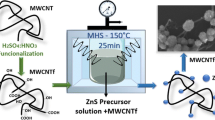Abstract
The surface modification of carbon nanotubes (CNTs) has been recently observed to influence the distribution of CNTs in epoxy resin and the mechanical properties and electrical conductivities of these CNTs. Accordingly, the treatment of multi-walled carbon nanotubes (MWCNTs) with organic acids to oxidize them to generate functional groups on the surface of MWCNTs is a prime task to carry out the surface modification of MWCNTs in this study. This investigation studies the consequent enhancement of their mechanical properties and electrical conductivities. Varying proportions of MWCNTs added to epoxy resin were compared in terms of their effects on mechanical properties such as strength and electrical conductivities of the resulting composites at different temperatures. The test results also indicate that mechanical strength and electrical conductivity increase with the amount of MWCNTs added to the composites. Different coefficients of expansion of the matrix, fiber and CNTs, are such that overexpansion of the matrix at high temperature results in cracking in it. An SEM image of the fracture surface reveals debonding and the pulling out of longitudinal fibers because of poor interfacial bonding between fiber and matrix, which reduce overall strength. Moreover, the creep behaviors of carbon fiber (CF) /epoxy resin thermosetting composites and MWCNTs/CF/ epoxy resin composites were tested and analyzed at different stresses, orientations of fiber, temperatures and humidities. The creep could be classified into two stages: primary and steady-state. The effects of creep stress, creep time, and humidity on the creep of composites containing varing proportions of MWCNTs were investigated at various temperatures. Additionally, creep strain decreased as the number of cycles in cyclic creep tests increased at room temperature and at a high temperature of 55 °C. Possible room temperature creep mechanisms have been proposed and discussed. With increasing number of creep tests, the creep strain decreased due to strain hardening which occurred during creep. Creep strain is believed to increase with applied stress, creep time, humidity, temperature and degree of the angle θ between the orientation of the fiber and the direction of the applied stress. The decrease in creep strain of CF/epoxy resin composites was also investigated after aging pretreatment in a constant temperature and humidity chamber for varying durations before creep testing. Finally, the Findley power law was used to fit the curves for creep strain in the CF/epoxy resin composites and MWCNTs/CF/epoxy resin composites under various test conditions.








Similar content being viewed by others
References
Cochet M, Maser WK, Benito AM, Callejas MA, Martinez MT, Benoit JM (2001) Synthesis of a new polyaniline/nanotube composite: “in-situ” polymerization and charge transfer through siteselective interaction. Chem Comm 16:1450–1451
Hayhurst DR (1972) J Mech Phys Solids 20:381
Finnie L, Heller WR (1959) Creep of engineering materials. McGraw-Hill Book Company, London
Bendersky L, Rosen A, Mukherjee AK (1985) Int Metal Rev 130:1–15
Mughrabi H (1991) Acta Metall Mater 139:3067–3070
Kumar S, Doshi H, Srinivasarao M, Park JO, Schiraldi DA (2002) Fibers from polypropyle- ne/nano carbon fiber composites. Polymer 43:1701–1703
Qian D, Dickey EC, Andrews R, Rantell T (2000) Load transfer and deformation mechanisms in carbon nanotube-polystyrene composites. Appl Phys Lett 76(20):2868–2870
Kortschot MT, Woodhams RT (1988) Computer simulation of the electrical conductivity of polymer composite containing matallic fillers. Polymer Compos 9(1):60–71
Novak I, Chodak I (2002) Investigation of the correlateion between electrical conductiveity and elongateion at break in polyurethane-based adhesives. Synthesis Metal 131:93–98
Chen CH, Chen YC (1994) The creep behavior of solid filled rubber composites. J Polymer Res 1(1):75–83
Zhang SY, Xiang XY (1992) Creep characterization of a fiber reinforced plastic material. J Reinforc Plast Compos 11:1187–1195
Gittus J (1975) Creep, viscoelasticity and creep fracture in solids. London: Appl. Sci
Keh A (1965) Phil Mag 9:12
Meier M, Blum W (1993) Proceedings of the Fifth International Conference for Creep Fracture of Engineering Materials and Structure, Swansea, 28 March–2 April, p 167
Oehlert A, Atrens A (1994) Acta Metal Mater 31:1473–1528
Findley WN (1944) Creep characterization of plastic. Proc. Symposium on Plastics. American Society for Testings and Materials, Philadelphia, PA
Findley WN, Lai JSY (1967) A modified superposition principle applied to creep of nonlinear viscoelastic material under abrupt change in state of combined stress. Trans Soc Rheol
Acknowledgements
The authors are grateful for the help of the Center for Nanotechology, Materials Science, and Microsystems at National Tsing-Hua University, Taiwan, R.O.C. Ted Knoy is appreciated for his editorial assistance.
Author information
Authors and Affiliations
Corresponding author
Rights and permissions
About this article
Cite this article
Li, YL., Shen, MY., Chen, WJ. et al. Tensile creep study and mechanical properties of carbon fiber nano-composites. J Polym Res 19, 9893 (2012). https://doi.org/10.1007/s10965-012-9893-6
Received:
Accepted:
Published:
DOI: https://doi.org/10.1007/s10965-012-9893-6



